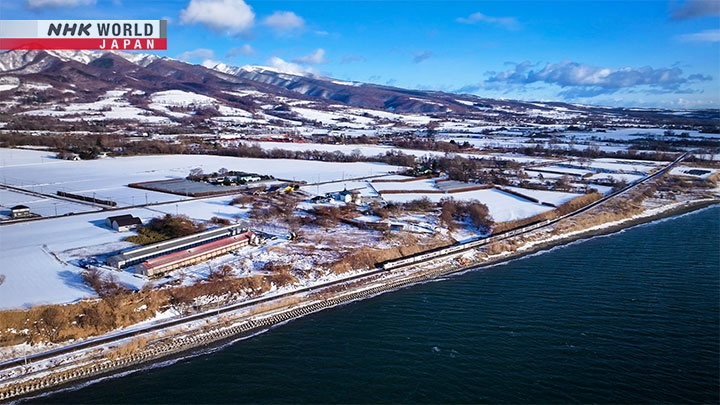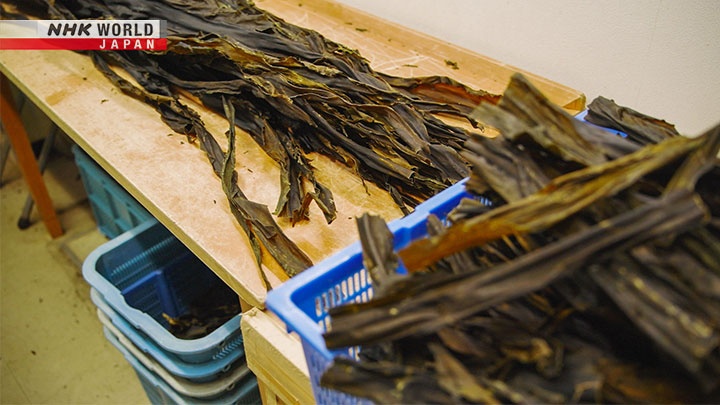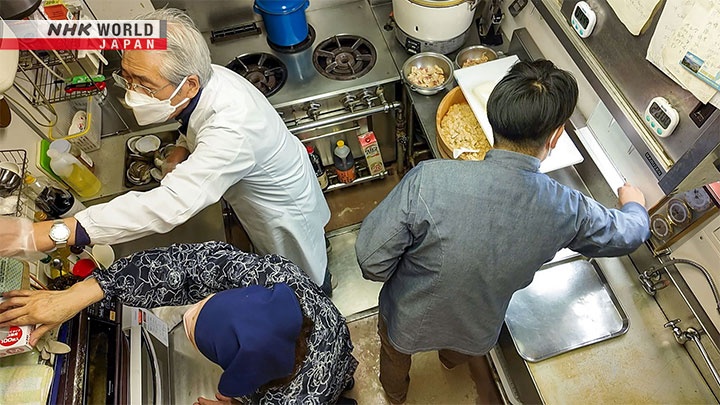Comfort Food from the Northern Seas
At Bokoi Station in Hokkaido Prefecture, a family trio makes just 40 ekiben per day. The surf clam called hokkigai, a regional comfort food, is locally sourced, along with the kombu and even the salt.






Transcript
Beautifully packed in various containers...
These bento abundantly incorporate local ingredients and are a delight for the palate as well as the eyes...
Yes, it's the uniquely Japanese culinary culture of ekiben.
Ekiben are typically purchased at train stations and enjoyed during train journeys.
Join us on a Japan's culinary journey exploring ekiben.
EKIBEN JAPAN!
Today, we're taking a look at a comfort food from the northern seas.
On the large island of Hokkaido, located in the northern part of Japan, the Muroran Line runs along the southwestern coastline.
The cozy Bokoi Station, nestled in the city of Muroran, is where the ekiben called Bokoi-Meshi is sold.
Made by three family members, they're limited to just 40 per day.
Because of their limited availability, they're known as a rare ekiben.
These customers traveled 800km for this ekiben.
My wife learned about the surf clam bento
sold here from television.
She was eager to try it
but never had the opportunity.
We're excited to try it now.
We'll enjoy it together.
Let's take a look at what's inside this rare ekiben.
The first thing that you'll notice when you open the box is a large clam of about 10cm in length.
Inside the shell is a beautifully arranged onigiri with ample clam meat.
As you take a bite...
the clam's sweetness fills your mouth.
With its soft texture and delicate flavor, it transports you to the sea.
This surf clam is called hokkigai.
The place name Bokoi is said to originate from a phrase meaning "a place with many hokkigai"
in the language of the Ainu, the indigenous people.
It's said that nearly 90% of hokkigai in Japan comes from Hokkaido.
Harvesting them is not an easy task.
The cold is tough in winter.
There's also waves, and wind too.
Sometimes there's snow, like today.
The weather is a factor.
I think it's -1℃ or -2℃ today,
but we still work even in -15℃.
In that temperature,
my legs sometimes hurt so much
that I want to cry, but I manage.
I really like hokkigai.
I could eat it every day.
When I'm at an izakaya with friends,
I'll order hokkigai, and they'll scold me.
"You harvest those yourself!"
That's how much l love them.
I'm lucky that I'm able to harvest
something that I'm fond of.
At a seafood market near the port, freshly caught hokkigai are put out for sale.
It's a long-living clam.
I don't know of any other clam
that takes this long to grow big.
These are about seven to eight years old.
These small ones.
These big ones are probably
about 35 years old.
35 years! Who knew clams could live that long!
Hokkigai are probably the most
versatile clams for cooking.
They're good in salads,
butter-grilled, fried...
My favorite is frying them.
I would say they can be
used in almost anything.
Hokkigai is something of a comfort food in this area.
Our restaurant has over 25 hokkigai
dishes on the menu now,
so you can probably experience
most hokkigai dishes in Japan.
Raw hokkigai sliced with skillful knifework...
is topped on rice to make a hokkigai rice bowl.
For those who prefer it cooked...
there's butter-grilled hokkigai, a dish with a fragrant aroma.
Hokkigai coated in batter and deep fried is a favorite of Yamamoto from the market.
And there's the restaurant's most popular dish.
Curry rice with briefly cooked hokkigai.
Three freshly-caught hokkigai are
used for our curry.
The sweetness from the hokkigai blends
really well with the curry. It's very delicious.
Let's gaze out towards Hokkaido's sea...
as we return to enjoying our ekiben.
These ekiben are made by three family members.
Equally as important as the hokkigai is the seasoned rice used for the onigiri.
The unsung hero that supports its flavor is kombu.
This kombu is called yayan kombu.
It's a kombu species only found in Muroran.
It's a valuable kombu species
as a specialty of Muroran.
Kombu, or kelp, is a type of seaweed essential for Japanese cuisine.
Yayan kombu, used in Bokoi-Meshi, thrive near the steep cliffs at Muroran's sea.
They're roughed up,
being battered by the waves.
"Yayan" means useless or just normal.
With that sort of name, this kombu species
has been overlooked for a long time.
Not many fishermen bother to collect yayan kombu since they look unattractive and are unprofitable.
However, having fallen in love with its flavor, Sekine Katsuji commissions fishermen to harvest yayan kombu for him.
I'm thankful.
Without this kombu, there would be no Bokoi-Meshi.
It's precious.
The important role of yayan kombu is in making dashi, or broth.
With a soup infused with the strong umami of kombu, rice is cooked like paella.
The dashi is made by Issei, Katsuji's son.
I'm careful not to let it boil
so the kombu's umami is preserved.
At 80℃ the thickening components
start to break down.
The kombu is simmered, with close attention paid to the heat.
It's not just dashi from kombu.
There's also dried, smoked mackerel, and shiitake mushrooms.
Dashi is made from each of these ingredients,
and the three dashi are then combined.
This is crucial.
We make the dashi separately.
If you combine them when the ingredients
are still inside, the flavors will be absorbed.
The kombu absorbs the fish flavor
and the fish absorbs the kombu flavor.
It tastes good even without salt
because the umami stimulates your taste buds.
Even without salt,
it's delicious.
The carefully prepared dashi gives the onigiri a rich taste.
Together with the main ingredient, hokkigai, and the supporting yayan kombu,
there's one more ingredient in Bokoi-Meshi that ties the flavors together.
On this sunny day, Katsuji sets out for that ingredient.
He's heading out to sea together with Issei to collect seawater.
I realized that salt is the essence of flavor,
so I searched for the best salt.
But I couldn't find the right one.
Since Muroran is surrounded by the ocean,
I realized I had to make salt with seawater for the bento.
Using a pump, he fills ten 20-liter containers with seawater.
The seawater is boiled for an entire day.
It's then left to dry for another day to produce salt.
It's literally the salt of Muroran.
It comes back to the idea of offering
local produce to those who visit.
I don't think there's anybody
who makes salt just for bento.
That's unheard of, indeed.
The best thing is when people
express their appreciation.
We decided to be fully dedicated,
and this is how it's turned out,
so it's wonderful when our customers say
they enjoyed the bento.
Savoring the deep sentiments of this heartfelt bento, let's carry on with our journey.
EKIBEN JAPAN. Where to next...?